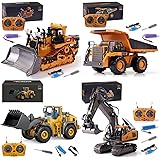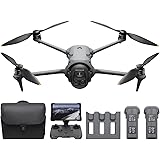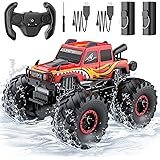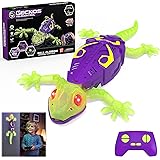Welcome back to the captivating world of remote-controlled flight. As discussed in the video above, venturing into aerial photography or simply seeking the thrill of acrobatic flight can often present a significant challenge, particularly when aiming for smooth, unobstructed cinematic results or customizability in your aerial platform. Traditional quadcopters, while popular, frequently introduce limitations such as propeller intrusion into camera views and a somewhat robotic flight demeanor, which can detract from the desired aesthetic or performance. This foundational issue, recognized by many hobbyists and professional aerial videographers alike, necessitates a more refined solution for discerning builders and pilots.
The solution, for many, lies in the distinctive design and operational advantages of a tricopter. This unique class of multicopter addresses these specific pain points by offering a compelling blend of maneuverability, inherent cinematic qualities, and an adaptable framework for customization. Through its innovative three-motor configuration and mechanical yaw control, the tricopter provides a more fluid flight experience and ensures propellers remain out of shot, creating a superior platform for a multitude of aerial endeavors. This detailed exploration will delve into the intricacies of tricopter design, highlighting its unique attributes and demonstrating why it stands as an exceptional choice for those ready to elevate their RC flight experience.
Understanding Tricopter Mechanics and Distinctive Design
Multicopters, widely recognized as drones, represent a diverse category of aerial vehicles, within which the tricopter holds a unique position. While quadcopters, with their four motors, often dominate the mainstream perception of drones, tricopters originated around the same era, showcasing an innovative approach to flight dynamics. Influential figures such as David Windestål significantly contributed to the early development and popularization of multicopters, including tricopters, long before sophisticated flight controller boards and integrated technologies were commonplace. His pioneering work involved sharing experiences and modifying platforms to carry cameras, inspiring a new generation of builders to pursue aerial videography.
The fundamental distinction between a tricopter and a quadcopter is immediately evident in their motor layouts. A quadcopter typically utilizes four motors, positioned at 90-degree intervals, whereas a tricopter is characterized by its three motors, generally spaced 120 degrees apart. This seemingly minor difference profoundly impacts flight characteristics and potential applications. With a tricopter, the specific motor arrangement means that propellers are inherently positioned further from the central body, significantly reducing the likelihood of them appearing in camera footage—a critical advantage for aerial photography and videography enthusiasts.
Dedicated Yaw Control: A Tricopter’s Mechanical Advantage
Beyond the simple motor count, the method of achieving yaw control sets the tricopter apart. Quadcopters rely on counter-rotating propellers and differential motor speeds, orchestrated by the flight controller board, to induce yaw. This electronic manipulation of torque imbalance allows for precise rotational adjustments, but it often results in a distinctly “robotic” stop when yaw input is ceased. The abruptness of these movements can be quite noticeable in video projects, potentially distracting from the intended visual narrative.
Conversely, a tricopter employs a mechanical solution for yaw: a servo-controlled tilting mechanism on its rear motor. This elegant design allows the rear motor to pivot, directly vectoring its thrust to create yaw. When the control stick is released, the servo motor gradually returns to its neutral position, which provides a natural, smooth deceleration of the yaw motion. This “overshoot” effect mimics the fluid movements expected from a human operator, delivering more natural-looking cinematic sweeps and pans. Furthermore, this mechanical approach facilitates much higher yaw speeds compared to the electronic motor slowing technique used by quadcopters, enhancing agility and dynamic maneuverability.
Advantages of Tricopter Designs for Aerial Applications
The unique operational dynamics of a tricopter translate into several tangible benefits, making it a preferred choice for specific aerial tasks. Understanding these advantages is crucial for anyone considering a custom build or investing in an advanced remote-controlled aircraft.
- **Fluid and Natural Flight Characteristics:** The dedicated mechanical yaw control, combined with the tri-motor configuration, imparts a significantly more fluid and organic flight feel. When a tricopter moves into forward flight and executes banks, pitches, and yaws, its movements emulate an airplane. However, its ability to slow down and hover precisely like a helicopter is maintained, offering a versatile flight envelope. This hybrid flight dynamic is particularly appreciated for cinematic purposes, where smooth, predictable movements are paramount.
- **Unobstructed Camera View:** The 120-degree separation of motors on a conventional tricopter, and even wider 150-degree separation on specific designs like the Maker Hangar kit’s front arms, ensures that propellers remain completely outside the camera’s field of view. This fundamental design benefit eliminates the frustrating problem of prop-wash and propeller blades appearing in footage, which is a common issue for quadcopters carrying wide-angle cameras like GoPros.
- **Enhanced Agility and Precision:** The direct mechanical control of yaw allows for incredibly agile maneuvers and rapid changes in orientation. While quadcopters achieve stability through electronic compensation, the tricopter’s design allows for a more direct, intuitive connection between pilot input and aircraft response. This makes tricopters exceptionally fun for performing stunts and acrobatics, appealing to pilots who enjoy a more dynamic flying experience.
- **Superior Vibration Absorption (with specific materials):** The choice of frame material plays a crucial role in mitigating vibrations, which are the enemy of clear video footage. As observed with kits constructed from natural materials like wood, an inherent vibration-dampening property is realized. This natural absorption capability, often enhanced by specialized vibration absorbers, ensures that even unbalanced propellers yield stable and jiggle-free video, critical for professional-grade aerial videography.
These collective advantages underscore why the tricopter, while less ubiquitous than the quadcopter, retains a dedicated following among enthusiasts who prioritize specific flight characteristics and high-quality aerial content capture.
The Maker Hangar Tricopter Kit: Innovations for the DIY Enthusiast
Designed with the “maker” community firmly in mind, the Maker Hangar tricopter kit introduces several thoughtful innovations that simplify the building process, enhance performance, and maximize customization potential. This kit is a testament to applying practical engineering principles to common multicopter challenges, particularly for those engaged in DIY projects and aerial photography.
Thoughtful Material Selection: The Power of Wood
The primary material utilized for the Maker Hangar tricopter frame is wood, a choice that might initially surprise some given the prevalence of carbon fiber or aluminum in modern drone construction. However, wood offers distinct advantages that are highly beneficial for builders:
- **Exceptional Hackability:** Wood is incredibly amenable to modification. Drilling new holes, cutting different shapes, or even integrating additional components becomes a straightforward process. This “hackable” nature encourages experimentation and personalization, allowing builders to truly make the aircraft their own without specialized tools or complex fabrication techniques.
- **Natural Vibration Absorption:** For aerial video work, vibrations are a critical concern, capable of degrading even perfectly framed shots. Wood, as a natural material, possesses inherent vibration-dampening qualities. This characteristic significantly reduces the transmission of motor and propeller vibrations to the camera platform, contributing to much smoother and clearer video footage.
- **Ease of Repair:** Inevitable crashes are a part of the RC hobby. Wood frames are often easier to repair than those made from more exotic materials, allowing for quick fixes with common workshop supplies.
Optimized Frame Design for Builders
The physical structure of the Maker Hangar tricopter frame has been meticulously engineered to address common frustrations encountered during multicopter assembly and maintenance:
1. **Spacious Body Layout:** Many tricopters feature compact bodies, making it exceedingly difficult to access nuts, bolts, and wiring once electronics and flight controller boards are installed. The Maker Hangar design, in contrast, provides ample internal space. This generous layout ensures that all critical fasteners and components remain easily accessible, even with larger format controller boards in place. Such a design vastly simplifies wiring, component upgrades, and general maintenance, saving builders considerable time and effort.
2. **Optimized Arm Angles:** While a standard tricopter maintains 120-degree arm separation, the Maker Hangar kit cleverly employs a slightly larger angle of approximately 150 degrees for its front two arms. This innovative adjustment permits the use of shorter arms without sacrificing the crucial “no propellers in camera view” advantage. Shorter arms inherently lead to increased agility, allowing the tricopter to be more nimble and responsive during flight, which is excellent for dynamic aerial maneuvers and chasing subjects.
3. **Integrated Vibration Absorber:** To combat vibrations even further, the kit incorporates a wire rope vibration absorber. This specialized component is exceptionally effective at isolating the camera platform from residual vibrations, ensuring unparalleled video stability even when propellers are slightly unbalanced. Such a feature underscores the kit’s dedication to high-quality aerial videography.
4. **Robust Tail Mechanism:** A carbon hinge is employed in the tail mechanism, providing a very strong yet exceptionally smooth bond between the tilting motor and the main frame. This robust construction ensures precise and consistent yaw control, contributing to the tricopter’s signature fluid flight characteristics and high yaw speeds. The kit also includes all necessary hardware for linking the servo to this moving motor assembly, ensuring seamless integration.
5. **Convenient Portability:** For ease of transport and storage, the front two arms of the Maker Hangar tricopter are designed to fold neatly alongside the back boom. This practical feature is complemented by a built-in locking mechanism, which securely prevents the arms from accidentally folding back during flight, ensuring safety and structural integrity. This combination of portability and secure operation makes the kit ideal for on-the-go pilots and videographers.
Overall, the Maker Hangar tricopter kit represents a thoughtful and comprehensive solution for anyone passionate about multicopters or aspiring to achieve superior aerial photography results. Its carefully considered design elements, from material choice to mechanical innovations, make it an outstanding project for builders of all levels, providing a foundation for both exhilarating acrobatic flights and professional-grade cinematic endeavors.











